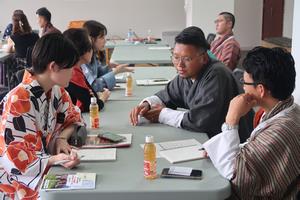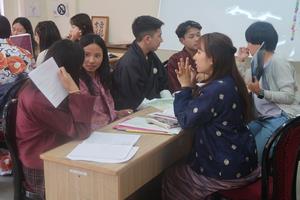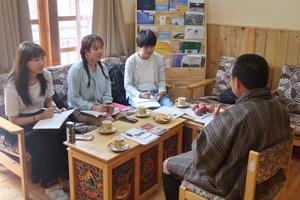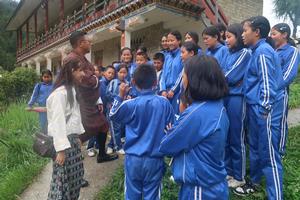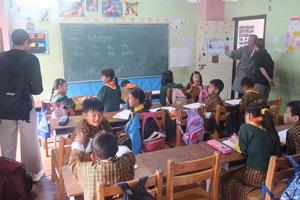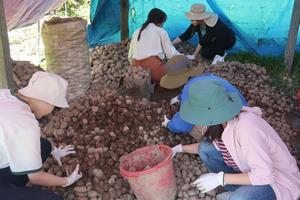- Global Collaboration Center
- Activity
- Report on Bhutan Study Tour (2024)
ページの本文です。
Report on Bhutan Study Tour (2024)
2025年3月17日更新
From August 19 to August 28, 2024, a study tour to Bhutan was conducted as a part of the course “Practicum for the Convivial Global Society FY2024”.
This year’s participants included five undergraduates: three first-year students, one second-year student, and one third-year student. Based on their majors and interests, the participants set research topics, such as “Coexistence of traditional architecture in urbanization of Bhutan and residents’ awareness,” “Relationship between religion and people in Bhutan,” “Regional differences in education and educational values in Bhutan,” “Environment surrounding primary education in Bhutan,” and “Relationship between education and views on children in Bhutan,” and conducted field visits and interviews.
In the study tour, we participants stayed three nights in Thimphu, the capital of Bhutan, two nights in Haa, and two nights in Paro. Upon arrival at Paro International Airport, we were warmly welcomed by our guide and driver, who draped a white cloth around our necks as a sign of welcome. In Thimphu, we visited the JICA Bhutan Office, the Bhutan Centre for Japanese Studies, a Christian church, a private primary school, the Ministry of Education and Technological Development, a Hindu temple, and a traditional arts and crafts center. We enjoyed walking around the city with the students of the Bhutan Centre for Japanese Studies, communicating with them in both Japanese and English, looking at souvenirs, and having tea, which deepened friendship with them. We also visited Changlimithang Stadium and a store selling kira fabrics.
At Haa, located a three-and-a-half-hour drive from Thimphu, we visited a public primary school and an Early Childhood Care and Development (ECCD) Center to compare the differences in education between urban and rural areas, as well as between private and public schools. We also met Mr. Takaesu, a JICA volunteer who teaches physical exercises at the local school, to learn the lifestyles of local children. During our stay at the farmhouse, we enjoyed authentic Bhutanese meals such as Ema Datshi (chili cheese) and Phak Sha Paa (pork stewed with radish). During dinner, the farmer’s father told us stories about his yak herding experience, and his younger brother, a monk, also thought us about Tibetan Buddhism.
In Paro, we hiked to several monasteries, including Lhakhang and Taktsang. It took about two hours one way to reach Taktsang Monastery. On the way to the monastery, we practiced prostration while listening to the guide’s commentary, experiencing Tibetan Buddhism firsthand.
During the study tour, I was deeply enchanted and comforted by the culture and people of Bhutan, the Bhutanese chili recipes, the beauty of the traditional architecture, and the kindness of the locals. We visited two primary schools and three ECCD centers, where we interacted with teachers and children. The children were very friendly and adorable, and I enjoyed talking with them in English. I was particularly impressed by the fluency and ease of understanding that the urban primary school children displayed when speaking English. It seems likely that they frequently watch English videos on the internet from a young age, which is probably the reason for this. As a person who loves mountains, I was captivated by the breathtaking scenery visible from every angle. I felt a sense of nostalgia for the way people live, the architecture, and the landscapes surrounded by lush greenery. I found Bhutan to be a very comfortable country.
Throughout the study tour, I felt that Bhutan is a country that blends the old and the new. For example, at the public primary school in Haa, I saw students in traditional classrooms using European learning tools while studying on computers. At the public ECCD center, children and teachers primarily spoke in the official language, Dzongkha, while most of the posters were prepared in English. According to an official from the Ministry of Education, education in Bhutan aims to develop both the ability to live within traditional culture and the capacity to play an active role in global society. In Bhutan, the only traffic signal is a hand signal. There are no traffic signals after the officers’ work hours are finished, but drivers continue to give way to one another even without instructions. Additionally, animals act like a red light. I frequently saw cows, horses, birds, and dogs walking on the road, and cars would stop until the animals finished crossing. Despite the occasional accidents, I was impressed by people’s ability to maintain smooth traffic without traffic lights. Observing this combination of old and new, with even elderly adeptly using smartphones, but no traffic lights on the roads was a fascinating sight. The unique combination increased my interest in Bhutan even more.
Throughout the study tour, I came to appreciate the significance of visiting the site. By relating the stories of the guide and the monks to daily life, my understanding of the values of Tibetan Buddhism gradually deepened. I realized how deeply Tibetan Buddhism is embedded in people's lives when I saw the colorful flags adorning the houses, the prayer wheels scattered everywhere, and the elderly people walking clockwise while holding prayer beads and chanting sutras. It was surprising to see the royal family photos displayed in various places, such as in homes and on brooches, where I felt the essence of Tibetan Buddhism and the royal family. These insights came to me only through visiting Bhutan and experiencing it with all my senses—tasting the local food, interacting with the Bhutanese people, and being surrounded by the architecture and nature. I was able to experience Bhutan firsthand and gain a deeper understanding of its significance.
I hope that I can deepen my understanding of Bhutan and promote intercultural understanding in other regions by reflecting on the experiences of this study tour through follow-up learning.
(Noriko Shirakawa, junior student, Department of Human and Social Sciences, Faculty of Letters and Education)





